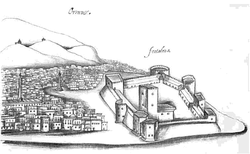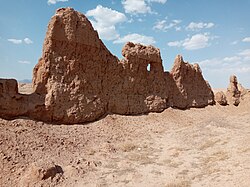This article needs additional citations for verification .(August 2010) |
| Fort of Our Lady of the Conception | |
|---|---|
| Hormuz Island in Iran | |
 The Portuguese Castle on Hormuz Island | |
 The Portuguese Castle in Qeshm | |
| Site information | |
| Type | Fort |
| Location | |
 | |
| The Portuguese Castle (Gaspar Correia-"Lendas da Índia", c. 1556) | |
| Site history | |
| Built | 1515 |
| Materials | Stone |
You can help expand this article with text translated from the corresponding article in Portuguese. (December 2015)Click [show] for important translation instructions.
|
The Fort of Our Lady of the Conception, also known as the Portuguese Castle, is a red stone fortress on Hormuz Island, Iran. It is one of the last surviving monuments of Portuguese colonial rule in the Persian Gulf. Ormuz (or Hormuz) was an important maritime city and a small kingdom near the entrance to the Persian Gulf. The original site of the city was on the north shore of the Gulf, about 30 miles east of the current Bandar Abbas. Around 1300, apparently in response to attacks from the Tartars, it moved to the small island of Gerun, which can be identified as the Organa of Nearcho, about 12 miles west and 5 miles from the coast.
Contents
Constructed on reddish stone on a rocky promontory at the far north of the island, the castle was originally cut off from the rest of the island by a moat, traces of which still remain. Although most of the roof caved in long ago, much of the lower part of the very substantial outer walls is intact, with the remains lying on different levels of the site.



















